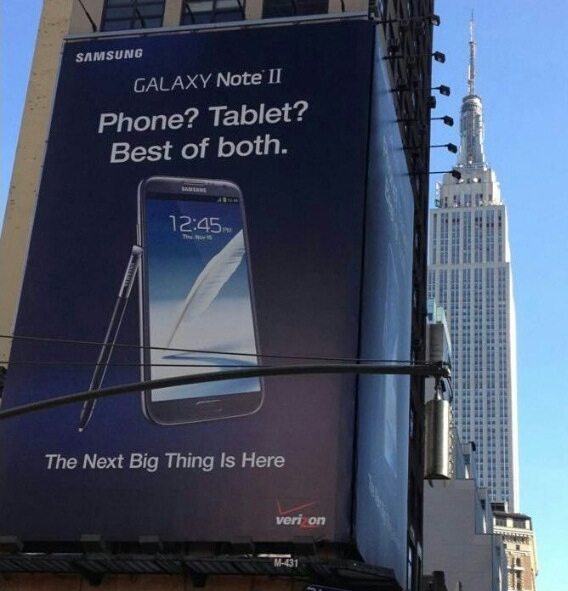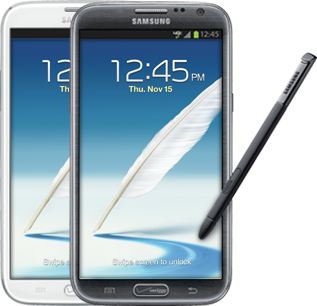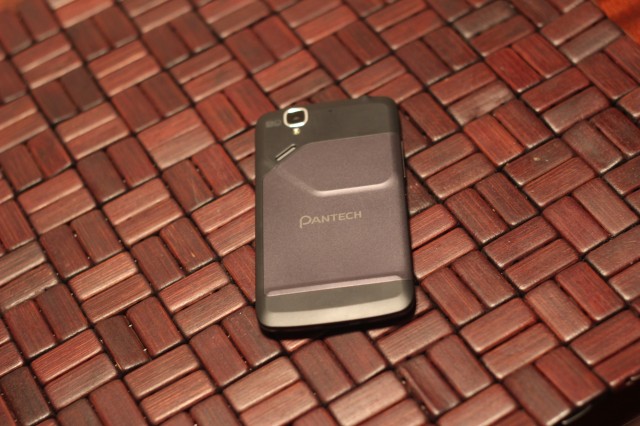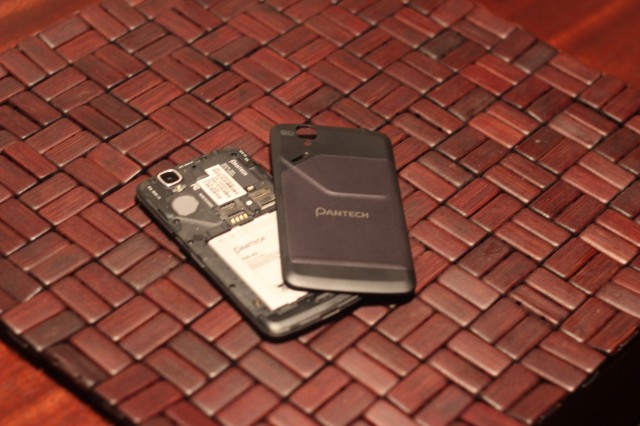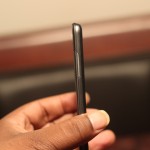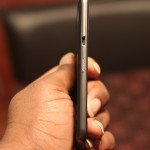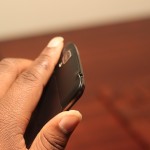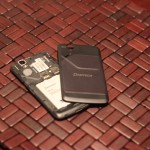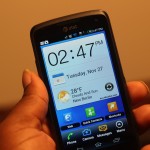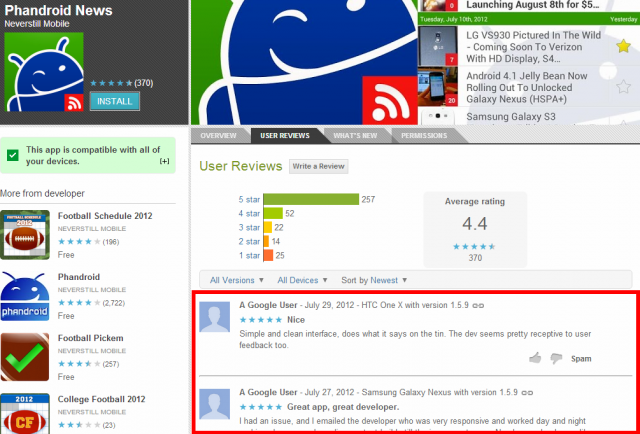Android Authority |
- U.S. Cellular introduces the Samsung Galaxy Axiom, a 4G LTE smartphone for $79
- HTC gets a new Chief Marketing Officer, but will new ads fix HTC’s problems?
- Android starting to erode iPad’s dominance
- Jelly Bean coming to Samsung Galaxy S3 in Canada on December 3
- The paradox of Android engagement: why you’re not buying enough from your Android device
- Full HD quad-core Oppo Find 5 coming on December 12th with 12 megapixel camera
- Chrome for Android to catch up with the desktop version of Chrome in early 2013
- Verizon Galaxy Note 2 starts shipping, branded home button still very much in the picture
- Google now accepting pre-orders for books on the Play Store
- Nexus 4 not sold out, it’s just Google unable to keep up with ‘very high traffic’
| U.S. Cellular introduces the Samsung Galaxy Axiom, a 4G LTE smartphone for $79 Posted: 28 Nov 2012 02:26 AM PST
It may look like the Samsung Galaxy S3 Mini, but it's not. What you're seeing on your screen is the Samsung Galaxy Axiom, the phone that was outed earlier in the month and was hinted to head to U.S. Cellular. If you're intrigued by the marginally better specs that the Galaxy Axiom has compared to the Mini, we're here to tell you that U.S. Cellular has now made the phone official. You can get the Galaxy Axiom on contract or without. The price for the former is $79 with a two-year service agreement, while the latter will set you back $399. Some of the things that set the Axiom apart from its doppelganger are the inclusion of a dual-core 1.2GHz Qualcomm MSM8960 processor and 4G LTE radio. As for the drawback, the phone will only ship with Android 4.0 Ice Cream Sandwich. Other features include a 4-inch display with 480 x 800 resolution, 4GB onboard storage, microSD support (up to 32GB), 5MP rear camera with LED flash, 1.3MP front-facing camera, NFC, and 2,100mAh battery. It's worth to note that the Axiom supports Google Wallet out of the box. Hit the source to get more details of the Samsung Galaxy Axiom. Related Posts |
| HTC gets a new Chief Marketing Officer, but will new ads fix HTC’s problems? Posted: 28 Nov 2012 02:22 AM PST
HTC has just announced that John Wang (pictured above), their current Chief Marketing Officer (CMO), will be replaced by Benjamin Ho. When does Benjamin take over John’s position? Next month. What sort of credentials does this guy have? According to The Next Web, he used to be the CMO of Motorola, and he was once responsible for the marketing strategy at the Taiwanese operator FarEasTone. What is Benjamin going to do differently than his predecessor? We have no idea. HTC is calling their new marketing strategy “Marketing 2.0″ internally, which is just about the most vague name one can assign to a project. The sad reality that HTC has to face is that Samsung spends an insane amount of money on marketing. According to the independent analyst Benedict Evans, Samsung is currently spending roughly $11 billion a year on ads. Now yes, Samsung markets more than just smartphones, but to put that number into some perspective, HTC had revenues of $2.4 billion in Q3 2012 and they expect to hit around $2 billion this quarter. In other words, Samsung spends more money on advertising than HTC makes by selling mobile phones. Can a new marketing guy really fix things at HTC? We’re going to have to say no. HTC’s problems have more to do with their infatuation with Sense UI, their stale design language, and their inability to stand up to operators who want custom hardware. We’re not saying HTC deserves to disappear, because more competition is better, but we’re struggling to see how advertising is going to turn this sinking ship around. Maybe HTC would be in a better position if they merged with another handset vendor? Huawei and ZTE are facing an uphill battle in mature markets because they don’t have any brand recognition. If they slapped HTC’s logo on the front of their devices, then that could change everything. Related Posts |
| Android starting to erode iPad’s dominance Posted: 28 Nov 2012 02:07 AM PST
ABI Research has revealed that the iPad made up 55 percent of tablet shipments in the third quarter while Android claimed a 44 percent share. That's a 14 percent decline for the iPad compared to the second quarter. Amazon, Asus, and Samsung are in the ascendancy with a strong range of Android tablets and sales are rising fast. We discussed this issue earlier this month after an analyst tried to answer the question – when will Android overcome the iPad? Sameer Singh predicted that mid-2013 will see Android take the lead in terms of shipments. The ABI analyst Jeff Orr is an agreement, "As the OS of choice for the majority of device OEMs [original equipment manufacturers], we expect the Android ecosystem to continue growing in numbers — new manufacturers, better device choices for reaching more markets, and more developers finding value from apps and content." Expectations are that the iPad mini will not do much to help Apple retain market share. Orr said, "With the introduction of a smaller, lower-cost iPad Mini, Apple has acknowledged Android’s beachhead of 7-inch-class tablets, though at the same time, it has failed to deliver a knock-out punch through innovation, pricing, and availability during the most critical selling period of the year." A lot of iPad sales are expected over the holiday season, but more and more people are choosing Android tablets and this looks like it will be the last Christmas that the iPad dominates the tablet market. Tellingly there was no mention of Windows 8. Related Posts |
| Jelly Bean coming to Samsung Galaxy S3 in Canada on December 3 Posted: 28 Nov 2012 01:31 AM PST
After taxes and death, you can bank on carriers to delay the latest Android roll out, in this case Jelly Bean for the Samsung Galaxy S3 in Canada. The software update was hinted to come to Rogers customers this month, but then got pushed back to early December. Can we hold to their words that it'll be arriving before the holiday? If Samsung Canada's tweet is anything to go by, it looks like your Galaxy S3 will be rocking Android 4.1 by next week. More specifically, the Jelly Bean update will be pushed out on Monday, December 3.
Naturally, the rollout will be done gradually, so it's best not to get your hopes up that it'll arrive on your handset on Monday. What's more, Samsung has left out a few details from the announcement, such as which carriers will be pushing it out first. We won't be surprised to see Rogers and Telus leading the way. Jelly time is almost here, folks. Aren't you excited? We'll update you when we hear more of the impending software bump up. Related Posts |
| The paradox of Android engagement: why you’re not buying enough from your Android device Posted: 28 Nov 2012 01:00 AM PST
The Black Friday weekend is usually a great time for retail establishments and marketers. Through the four days after Thanksgiving in the U.S., stores hold sales and deep discounts to encourage consumer spending. With the rise in popularity of mobile devices like smartphones and tablets, these platforms are also increasingly becoming popular as e-commerce — or mobile commerce — platforms. But while Android is on the rise nominally in terms of devices sold and in its market share, there seems to be a paradox at work. More and more people are buying Android smartphones and tablets. But the rate of engagement or online purchasing activity is not growing as fast.
Data from market analytics firm Asymco confirms this. Researcher Horace Dediu cites IBM Digital Analytics Benchmark’s study that Black Friday sales rose 17.4%, while mobile access grew by 24% from the previous year. But what’s interesting to note is the dominance of iOS devices in access and online purchases. For instance, smartphones made up 54% of the mobile access, while tablets made up 46%. The iPad dominated iPad traffic at 88%, while Android devices made up the minority. Kindle and Nook devices took 5.5%, Galaxy Tab devices 1.8% and other devices 4%.
From the previous year’s Black Friday, Android devices grew by a factor of 3.4, while iOS devices grew by 4.8. Interestingly, both the iPhone and iPad quickly overtook Android in terms of percentage of Black Friday online shopping activities. The big question here is what is causing the disparity in behavior. “What is causing phone users to behave differently based on the devices they own?” asks Asymco, noting that the mobile market has grown more mature in the past year. What’s clear with Android at this point is that “engagement is down as ownership is up.” A few thoughts, based on the analysis:
Asymco’s analysis did not say exactly what cause these differences. But the comment thread offers a few interesting insights into how the data could be interpreted. For example, there is question on how exactly Google counts Android activations. Do they double count a device when the device is updated? Another possible reason is the flood of “cheap, badly designed Android phones” that don’t exactly make for a good web browsing or e-commerce experience. I have a concern with the so-called Android engagement paradox, though. Amazon seems to have found success in its Kindle Fire lineup even if it is selling each device at a loss. They recoup the investment through sales of content and merchandise. Does the Black Friday data mean that device-makers who bank on content sales like Amazon are set to lose out in the long run? As an Android user, how active are you in buying content and items using your smartphone or tablet? Related Posts |
| Full HD quad-core Oppo Find 5 coming on December 12th with 12 megapixel camera Posted: 28 Nov 2012 12:49 AM PST
As well as the quad core CPU and full HD (1920 x 1080 pixels) display, your 600 bucks get you Android 4.1 Jelly Bean, 2GB of RAM, 16GB of flash storage, GPS & A-GPS and a 12 megapixel camera. The phone can take two SIM cards, one for GSM and one for GSM+3G, however the 3G frequencies might not cover the ones in your geographical location. It supports 850/1900/2100MHz and the key missing number is 900MHz, which lots of countries in Europe use. If you don’t fancy a Chinese grey import, then there is of course the HTC J Butterfly (also known as DLX / DROID DNA) and there are rumors of upcoming full HD phones from Samsung (Galaxy S4), LG (Optimus G2), and ZTE (Nubia 5). There is an Oppo Find 5 promotional video out there, it is all in Chinese but it is still quite fun to watch: Related Posts |
| Chrome for Android to catch up with the desktop version of Chrome in early 2013 Posted: 27 Nov 2012 11:33 PM PST
Google’s Chrome browser is the best browser on the planet, period. That title used to be held by Mozilla’s Firefox, but man, those engineers really just let themselves go. Now some of you might be wondering, how come the desktop version of Chrome is at version 23 while Chrome for Android is stuck somewhere around version 18? According to Google Chrome’s Google+ page (try saying that three time fast), this will soon no longer be the case. Here’s the exact quote:
This is obviously great news, but why? Let’s take a step back and remind ourselves of how software updates used to work before Android and iOS. If your device was lucky enough to get updated, said update wouldn’t add new features, it would fix bugs. With the rise of smartphones, people started expecting regular updates, but since the browser was part of the core operating system, it only got updated when the whole device got updated. Think about that for a second. Imagine if you had to wait for Microsoft to release a new version of Windows to get a new version of Internet Explorer. Crazy, right? With Chrome for Android, it’s just another application installed on your phone, which means it’s now able to get updated whenever Google feels like pushes out an update. On the desktop side, Chrome gets bumped up a version number every couple of months. To see that kind of progress come to the phone side in 2013 is not only incredibly welcome, it’s downright revolutionary. And hey, if you don’t use Chrome for Android because you prefer the stock browser or even Opera … maybe you should consider switching. Related Posts |
| Verizon Galaxy Note 2 starts shipping, branded home button still very much in the picture Posted: 27 Nov 2012 06:55 PM PST
U.S. Galaxy Note 2 fans that desperately wanted to buy the device from Verizon should be happy to hear that the 5.5-inch handset is approaching its official launch. Better late than never, right? Some of those folks that pre-ordered the device have been told that their Galaxy Note 2 will ship starting with November 27, and DroidDog apparently can confirm that Verizon has indeed started to ship the device. The handset should be soon available in brick-and-mortar Verizon locations as well, so if you want to check out the device – branded home button included – before you buy it, then you should definitely check with your local Verizon stores to see when they're getting it. As for that Verizon-branded home button, well, it looks like Verizon simply had to go for this stunt, even if it obviously meant launching the device much later than everyone else – and there are four other carriers stocking the same device in the country. On the same note, we can't be wonder why Samsung agreed to let Verizon "customize" its Galaxy Note 2. After all, just earlier this year it proved to the world that it's ready to take less crap from carriers by launching the same Galaxy S3 version, when it comes to product name and design, even though some internal components are different depending on what continent you get the device from. That said, let's hear it from Verizon Galaxy Note 2 buyers, did you get your device yet? Related Posts |
| Google now accepting pre-orders for books on the Play Store Posted: 27 Nov 2012 06:45 PM PST
Keeping up with Amazon and the Apple’s iBookstore, Google now allows you to pre-order books in the Play Store. This update follows another recent Play Store change related to app reviews, which are now linked to your Google+ account. If you go to the Play Store and click on Books, one of the featured stories will have the heading “New And Coming Soon” which has a list of the all the books available for pre-order. Standard pre-ordering policies apply, which means that you will get charged only once the book is available and you can cancel your order at any time. There is already a wide range of books available, including titles by Tom Clancy, Sebastian Faulks and Sara Shepard. It is great that Google has decided to implement this system even if books aren’t available yet. Once you order a book you are reserved a place in the queue without actually paying anything at the time. Even though this method does postpone the payment, it does take the thought off your mind. To see what books are available for pre-order right now, hit up the source link below. Your experience should be pretty seamless, but let us know if you encounter any hiccups. Related Posts |
| Nexus 4 not sold out, it’s just Google unable to keep up with ‘very high traffic’ Posted: 27 Nov 2012 04:30 PM PST
Today was filled with quite a few Nexus 4-related updates. We learned that Google will only let customers purchase up to two devices and that T-Mobile received more Nexus 4 stock. Later we heard that Google announced potential buyers that the handset will start selling again today, and then we told you that the Nexus 4 appeared to have sold out minutes after sales resumed. Well, it turns out that the Nexus 4 wasn't out of stock and it's just Google that wasn't able to keep up with demand for the handset. Or better said, it wasn't able to cope with the increased traffic, which resulted in plenty of users complaining about encountering errors and not being able to put their orders in. Normally, that wouldn't be such a big – deal would it? – as this isn't the first company selling stuff online that's experiencing problems during sales of a popular device. But considering that we're talking about Google here, a company that has a lot of experience when it comes to Internet traffic, servers, data centers and everything related to the online environment, you'd think it would be able to setup a system that wouldn't crash as fast as it did. The company posted a message on top of the Google Play Store to tell users the Nexus 4 was not out of stock:
But that doesn’t make things any better for disappointed buyers, does it? How was your Nexus 4 buying experience (in case you decided to buy one today)? When is your unit shipping? Related Posts |
| You are subscribed to email updates from Android Authority To stop receiving these emails, you may unsubscribe now. | Email delivery powered by Google |
| Google Inc., 20 West Kinzie, Chicago IL USA 60610 | |









 Although not the very first, Chinese phone maker Oppo will release a five inch full HD smartphone on December 12th. The device, which is powered by a Qualcomm Snapdragon APQ8064 Quad Core 1.5GHz CPU and a Qualcomm Adreno320 GPU, will sell for around $480 in China. Several Chinese international re-sellers are also already advertising the phone for around $599 for those in the west.
Although not the very first, Chinese phone maker Oppo will release a five inch full HD smartphone on December 12th. The device, which is powered by a Qualcomm Snapdragon APQ8064 Quad Core 1.5GHz CPU and a Qualcomm Adreno320 GPU, will sell for around $480 in China. Several Chinese international re-sellers are also already advertising the phone for around $599 for those in the west.




